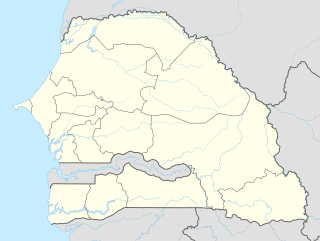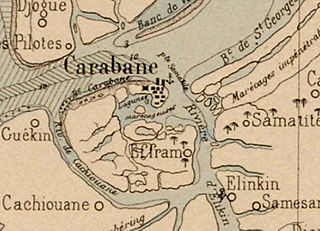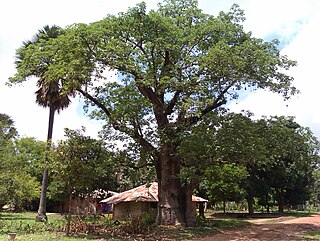| Thiobon | |
|---|---|
| Village | |
| Coordinates: 12°52′30″N16°32′57″W / 12.8750°N 16.5492°W Coordinates: 12°52′30″N16°32′57″W / 12.8750°N 16.5492°W | |
| Country | |
| Region | Ziguinchor |
| Department | Bignona |
| Arrondissment | Tendouck |
| Elevation | 6 m (20 ft) |
| Population (2002) | 1,387 |
Thiobon is a village of Senegal, located in lower Casamance, in the northeast of the subprefecture of Tendouck, 42 km from Bignona and 72 km from Ziguinchor. It is part of the Kartiack Rural community, in Tendouck Arrondissement, Bignona Department, Ziguinchor.

Senegal, officially the Republic of Senegal, is a country in West Africa. Senegal is bordered by Mauritania in the north, Mali to the east, Guinea to the southeast, and Guinea-Bissau to the southwest. Senegal also borders The Gambia, a country occupying a narrow sliver of land along the banks of the Gambia River, which separates Senegal's southern region of Casamance from the rest of the country. Senegal also shares a maritime border with Cape Verde. Senegal's economic and political capital is Dakar.

Casamance is the area of Senegal south of the Gambia including the Casamance River. It consists of the Lower Casamance and the Upper Casamance. The largest city of Casamance is Ziguinchor.
A subprefecture is an administrative division of a country that is below prefecture or province.
Contents
Creeks separate the village is from Baïla to the north and from Diouloulou and the islands of Carones and Carabane to the west. It is bordered on the south by the village of Mlomp and on the east by the village of Kartiack. Thiobon includes several uninhabited islands (Diadédiome, Koudièle, Djiyinène, Kayène-hourer, Kahahène, Diendiènaye, Kareugheul, Taminang, Houtanghate-Kouseumpoul, Houssoudia, Mainduènou) where rice farming is carried out and bird nesting site called Houlèouteuhou. Thiobon can be accessed by river or by road (Boucle du Blouf).

Baïla is a village in the rural community of Suelle, Sindian, Bignona, Ziguinchor, Casamance, Senegal.

Diouloulou is a small town and commune in the Bignona Department of the Ziguinchor Region of southwestern Senegal. In 2002 the town had a population of 2725 people.

Carabane, also known as Karabane, is an island and a village located in the extreme south-west of Senegal, in the mouth of the Casamance River. This relatively recent geological formation consists of a shoal and alluvium to which soil is added by accumulation in the branches and roots of the mangrove trees which cover most of the island. Along with the rest of Ziguinchor Region, Carabane has a tropical climate, cycling between a dry season and a wet season. The island was once considered an arid location where no useful plants were likely to grow, but it now supports several types of fruit tree, the most common of which are mangos and oranges. Although the nearby Basse Casamance National Park and Kalissaye Avifaunal Reserve have been closed for years because of the Casamance Conflict, Carabane has continued to attract ornithologists interested in its wide variety of birds. Various species of fish are plentiful around the island, but there are very few mammals.
The town is made up of five quarters: Amanque, Dablé, Erindian, Kabine and Kafone.









